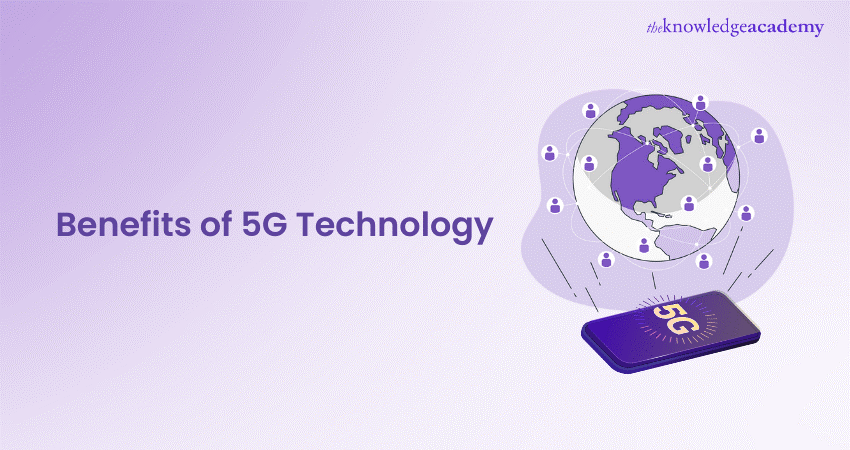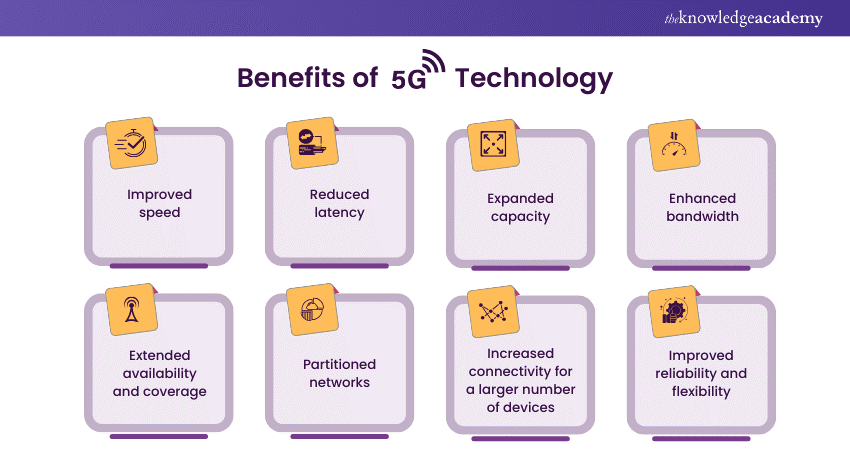We may not have the course you’re looking for. If you enquire or give us a call on +31 208081674 and speak to our training experts, we may still be able to help with your training requirements.
Training Outcomes Within Your Budget!
We ensure quality, budget-alignment, and timely delivery by our expert instructors.

As we progress towards major technological revolutions, we are gifted with unique innovations every year. 5G Technology is one such new cellular technology that has made building connections with people around the world easy. The Benefits of 5G Technology have significantly shifted in the digital world.
From enabling lightning-fast internet speeds to facilitating the Internet of Things (IoT), 5G technology stands to revolutionise how we interact with digital services and devices. Want to know how? Read this blog further to learn more about the Benefits of 5G Technology, its importance and how it has impacted the digital world.
Table of Contents
1) What is 5G?
2) What are the Benefits of 5G?
a) Improved speed
b) Reduced latency
c) Expanded capacity
d) Enhanced bandwidth
e) Extended availability and coverage
f) Partitioned networks
g) Increased connectivity for a larger number of devices
h) Improved Reliability and Flexibility
3) Conclusion
What is 5G?
5G is the Fifth-Generation technology introduced in the cellular network industry. It is the successor to the 4G networks that provide connectivity to most current cell phones. When it comes to performance, 5G is expected to bring much faster data speeds, lower latency, and more network management flexibility than its predecessor. This technology is built to handle a growing array of devices and services, from advanced mobile connections to IoT networks.
What are the Benefits of 5G Technology?
Now that you know What is 5G, Let’s discuss some of the Benefits of 5G Technology:

1) Improved speed
One of the most significant Benefits of 5G is its dramatically improved speed compared to previous generations. With the potential to reach peak data rates up to 20 Gbps, this technology is expected to be about 100 times faster than 4G. This speed enhancement allows for the downloading and uploading of data at unprecedented rates. This means almost instantaneous access to high-definition videos, virtual reality experiences, and other data-intensive applications for users.
For businesses, this translates into faster access to cloud platforms, enabling more efficient workflows and productivity. High-speed 5G networks can also revolutionise industries such as media and entertainment by allowing for seamless streaming of ultra-high-definition content and supporting new formats like 360-degree videos.
2) Reduced latency
Reduced latency is another unique Benefit of 5G Technology, representing a significant advancement over its predecessors. Latency, in telecommunications, refers to the time taken for a signal to travel from the source to the destination and back. This latency is reduced, potentially going as low as one millisecond, compared to around 50 milliseconds in 4G networks.
This latency reduction is critical for various applications where real-time response is crucial. It's also vital in the operation of autonomous vehicles, where split-second decisions made based on real-time data can be the difference between safety and collision.
3) Expanded capacity
Capacity, in the context of cellular networks, refers to the ability of the network to support a large number of simultaneous connections without degradation in service quality. 5G networks are designed to handle a significantly higher density of connections than 4G, accommodating the rising demand for internet connectivity in our increasingly digital world.
The expanded capacity of 5G is crucial in densely populated urban areas and large-scale events, where thousands of people might use data-heavy applications simultaneously. Where 4G networks might struggle with congestion under such circumstances, 5G can maintain high-performance levels, ensuring each user experiences consistent service.
Enhance your knowledge of the concept of Digital Twin and how it is deployed – register now for our Digital Twin Training!
4) Enhanced bandwidth
Enhanced bandwidth is a crucial feature of 5G Technology, significantly broadening the scope of what cellular networks can handle regarding data transmission. Bandwidth refers to the amount of data transmitted over a network at any given time. With 5G, this bandwidth is substantially increased, allowing for a much greater data flow than 4G networks.
This enhancement is crucial in accommodating the ever-increasing demand for data-heavy services and applications. For users, enhanced bandwidth means smoother experiences with high-definition video streaming, more efficient large-file downloads and uploads, and uninterrupted high-quality video calls. It also enables more complex online activities, such as sophisticated online gaming and immersive virtual or augmented reality experiences, which require transferring large amounts of data in real time.
5) Extended availability and coverage
Extended availability and coverage are crucial aspects of 5G Technology. It addresses one of the fundamental challenges of previous cellular networks - the inconsistency in service availability and coverage quality. It aims to provide a more uniform, extensive coverage beyond the urban centers and typical cell tower locations to encompass rural and remote areas, which have traditionally been underserved.
This expansion is made possible by using advanced technologies like small cells, which are miniature base stations deployed in various environments without the extensive infrastructure required for traditional cell towers. These small cells can be strategically placed in areas like urban buildings, light poles, or rural landscapes, effectively extending the reach of the 5G network.
6) Partitioned networks
Network partitioning, or network slicing, is a feature unique to 5G, allowing a single physical network to be divided into multiple virtual networks. This enables telecom operators to provide portions of their networks for specific uses. For example, a slice could be dedicated to IoT devices with low data requirements but needing extensive coverage, while another could be optimised for high-speed services like virtual reality. This flexibility allows for more efficient use of resources and the ability to tailor services to specific user needs, making 5G networks highly adaptable and efficient.
7) Increased connectivity for a larger number of devices
5G is designed to significantly increase the number of connected devices supported within the network. This is crucial for the growing IoT ecosystem, where an exponential increase in smart home devices, wearables, and sensors is expected. With 5G, these devices can connect reliably and work more efficiently, enabling smarter cities, homes, and industries. The ability to support a larger number of devices concurrently also means that 5G can facilitate large-scale IoT deployments, essential for industrial automation and smart city applications.
8) Improved reliability and flexibility
Partitioned networks, also known as network slicing in the context of 5G, represent a transformative feature that significantly enhances the flexibility and efficiency of cellular networks. Network slicing allows a single physical network infrastructure to be divided into several virtual networks, each tailored to meet specific requirements of different applications or services.
This partitioning is made possible by the advanced capabilities of 5G, which include Software-Defined Networking (SDN) and Network Functions Virtualisation (NFV). These technologies enable the dynamic allocation of network resources to create customised slices that vary in bandwidth, speed, capacity, and security.
For instance, a network slice could be dedicated to high-bandwidth, low-latency applications like augmented reality or autonomous vehicles, while another slice might be optimised for low-bandwidth, high-coverage IoT devices.
Are you interested in enhancing your knowledge of 5G Wireless services? Register now for our 5G Wireless Training!
Conclusion
After reading this blog, we hope you have understood the many Benefits of 5G Technology and its significant hold on the cellular and digital world. Its ability to bring wireless connections even in remote places, with reduced latency, expanded network capacity, and enhanced bandwidth, has helped in ensuring greater coverage and network partitioning. Thus, it has impacted various aspects of society and industry.
Do you want to learn more about some of the best advanced technologies? Join now for our Advanced Technologies Courses!
Frequently Asked Questions

The key Benefits of 5G over 4G include significantly higher data speeds, much lower latency, and greatly increased network capacity. 5G can offer data speeds up to 100 times faster than 4G, enabling rapid downloads and efficient streaming of high-definition content. Its reduced latency improves the responsiveness of applications, which is crucial for technologies like autonomous vehicles and remote surgery.

5G will greatly impact IoT by enabling more devices to connect simultaneously with reliable performance. This enhanced connectivity is due to 5G's higher bandwidth and capacity, which can accommodate the vast data generated by IoT devices. As a result, it will facilitate more sophisticated and widespread use of IoT applications, ranging from smart home devices to industrial IoT solutions, enhancing efficiency, automation, and data collection.

The Knowledge Academy takes global learning to new heights, offering over 30,000 online courses across 490+ locations in 220 countries. This expansive reach ensures accessibility and convenience for learners worldwide.
Alongside our diverse Online Course Catalogue, encompassing 17 major categories, we go the extra mile by providing a plethora of free educational Online Resources like News updates, blogs, videos, webinars, and interview questions. Tailoring learning experiences further, professionals can maximise value with customisable Course Bundles of TKA.

The Knowledge Academy’s Knowledge Pass, a prepaid voucher, adds another layer of flexibility, allowing course bookings over a 12-month period. Join us on a journey where education knows no bounds.

The Knowledge Academy offers various Advanced Technology courses, including 5G Wireless courses, Digital Twin, and Internet of Things IoT Systems and Applications. These courses cater to different skill levels, providing comprehensive insights into Advanced Technologies trends.
Our Advanced Technologies blogs covers a range of topics related to 5G Wireless, offering valuable resources, best practices, and industry insights. Whether you are a beginner or looking to advance your Project Management skills, The Knowledge Academy's diverse courses and informative blogs have you covered.
Upcoming Advanced Technology Resources Batches & Dates
Date
 5G Wireless Training
5G Wireless Training
Thu 5th Dec 2024
Thu 23rd Jan 2025
Thu 20th Mar 2025
Thu 22nd May 2025
Thu 17th Jul 2025
Thu 18th Sep 2025
Thu 20th Nov 2025







 Top Rated Course
Top Rated Course



 If you wish to make any changes to your course, please
If you wish to make any changes to your course, please


